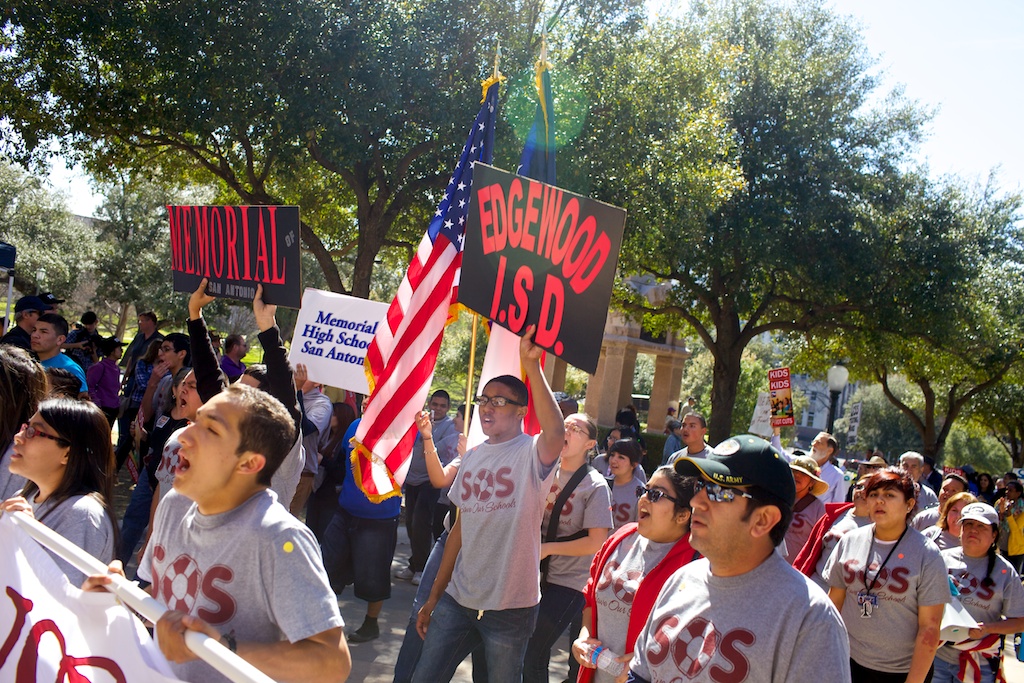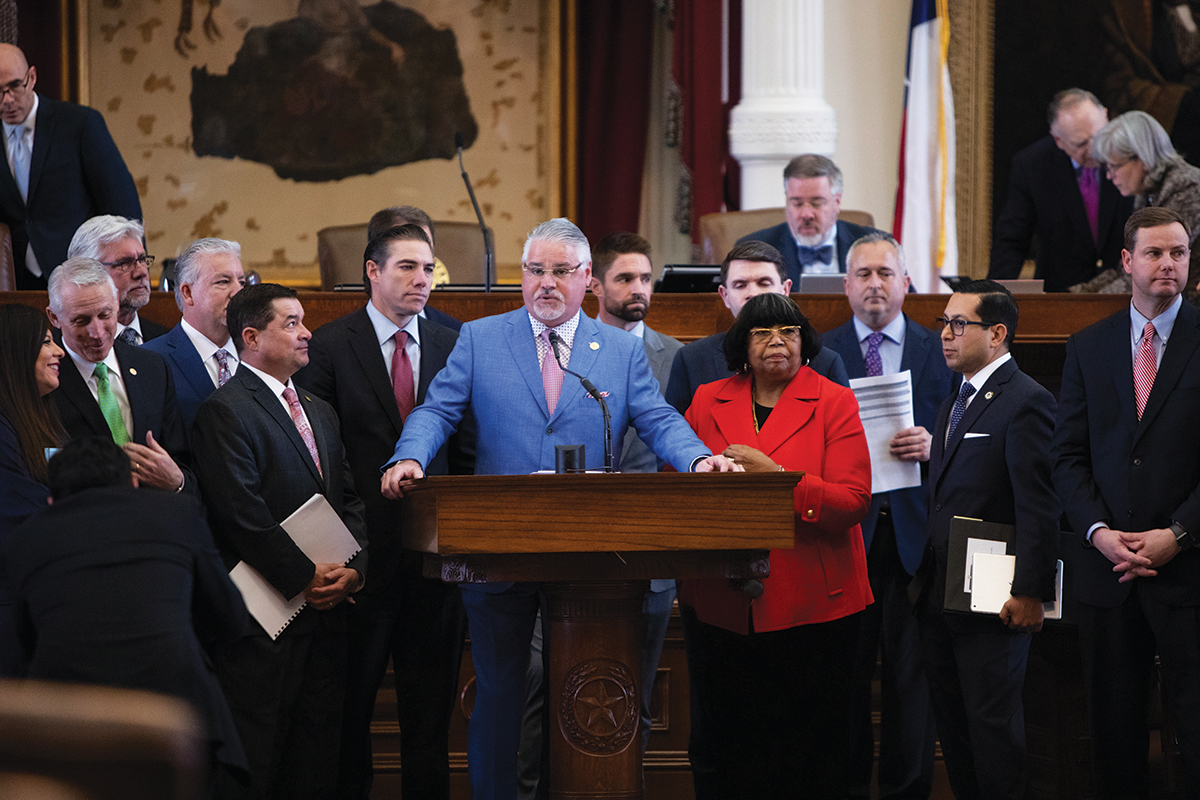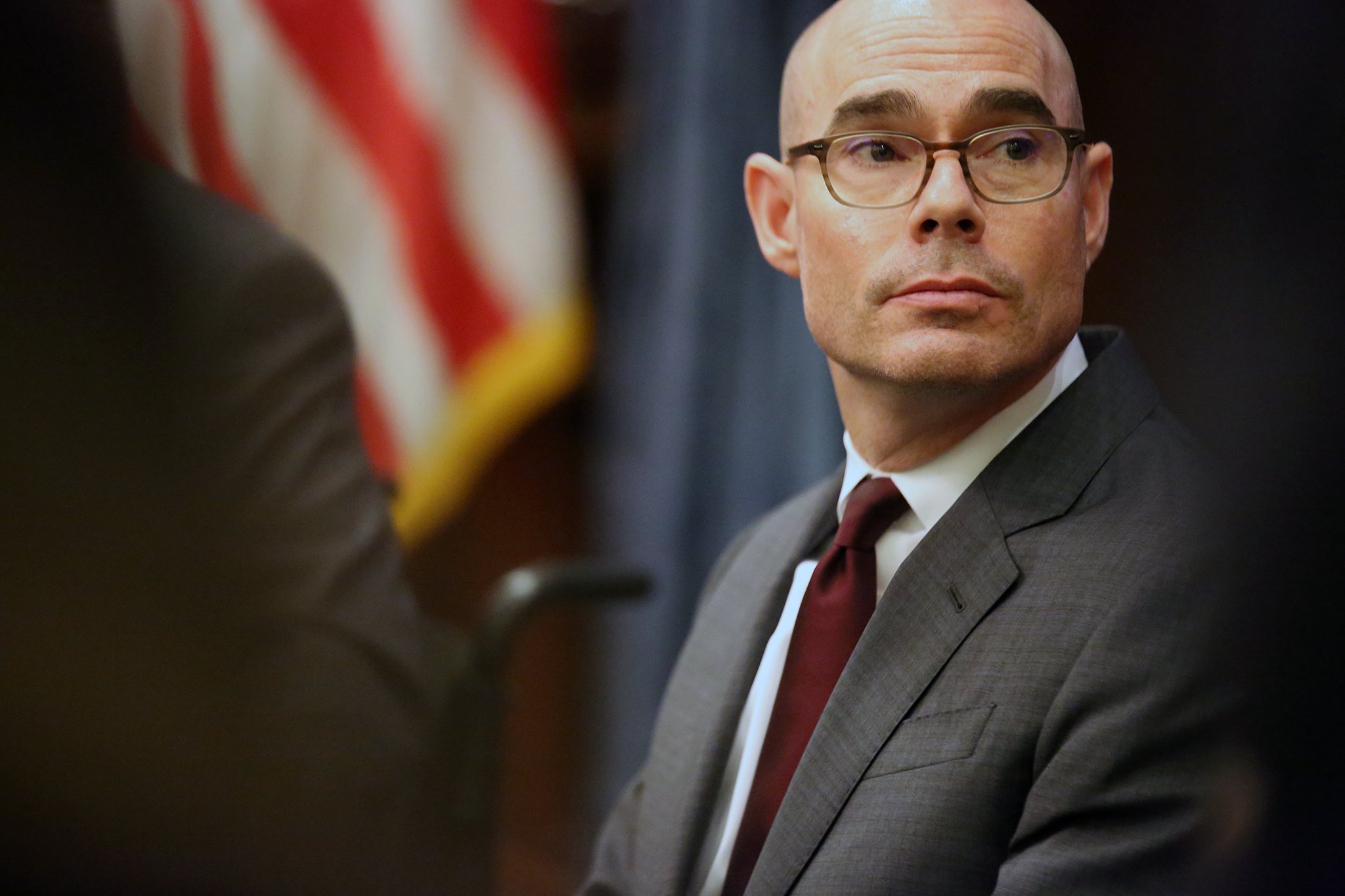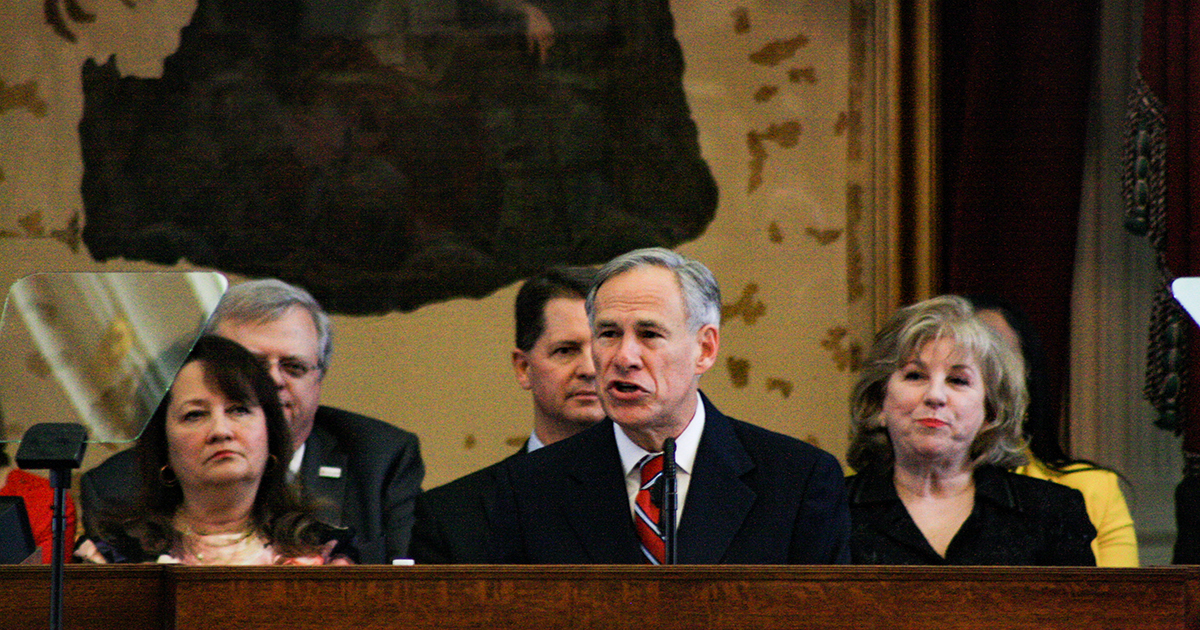
Everything You Need To Know About the Texas School Finance Ruling

Above: A contingent from San Antonio's Edgewood ISD at the Save Texas Schools rally in 2013.
A state district judge’s long-awaited ruling on Texas’ school finance case—siding with the more than two thirds of Texas school districts that sued the state claiming that our school funding system is unconstitutional—won’t be the final word on the matter. The Texas Supreme Court will ultimately decide the case, and if history is any guide, there’ll be another lawsuit like it within a decade.
But state District Judge John Dietz’s 383-page opinion in the case is important not only because it could be a step toward a better school system, but also because it covers so much ground. Backed by dozens of expert opinions, the ruling touches on the makeup of the student body to where Texas gets its teachers, from full-day bilingual learning to standardized test scores. Dietz’s ruling is an authoritative, exhaustive discourse on the state of Texas’ schools today.
There is one big point running through the sprawling opinion: When lawmakers have even attempted a close look at the real costs of education, they’ve ignored the results. Nor has the Legislature reviewed the impact of the cuts it made in 2011. That ignorance alone, Dietz says, violates the Texas Constitution.
The Legislature has been raising the standards for Texas students and requiring schools to provide more elaborate programs—talking big in the Capitol about the state’s high expectations—all while refusing to give schools the resources needed to meet those standards. It’s time, Dietz writes, that the state put its money where its mouth is.
Not enough money?! Come on, I heard that Texas’ school spending has never been higher.
That’s what a state witness said, too, showing that total spending—including construction—is way up since 2000. Dietz disagreed, saying it’s better to focus on “operations” spending, which has a greater impact on the classroom.
In constant 2004 dollars, Texas spent $7,128 per student a decade ago, peaked at $7,415 in 2009 (thanks to federal stimulus money), and bottomed out in 2013. Contrary to what you might have heard, Texas spends $300 less per student than it did a decade ago.
But just a few years ago, the Texas Supreme Court said we were spending enough.
A lot has changed since then. In 2005, the court ruled that the funding was barely adequate, but today a greater share of Texas students are economically disadvantaged or have limited English—both groups that cost much more to educate. Of Texas’ five million public school students, more than three million are economically disadvantaged. Dietz notes often that schools do have good options for helping these students (like smaller classes or full-day pre-K), but that these programs aren’t free—and the state’s not paying for them. While Texas’ bilingual population grows, it’s spending less on bilingual education.
All the new students we’ve added need new school buildings too, but Dietz said districts can’t raise enough for new construction. To pay for the growth, they’ve had to dip into money they should be spending in the classroom.
They can deal with it! It’s not like school’s getting any harder.
Oh, but it is. Since the last school finance ruling in 2005, the Legislature has added an expectation that schools prepare students for college, and begun using a harder new test, STAAR, that’s designed to assess a higher level of learning than the old test, TAKS. Both sides in the case agreed this was a “dramatic increase” in what students are expected to do.
Even last year’s House Bill 5, which cut the number of tests and added “career-ready” alternatives to the college-ready standard, doesn’t change that. In fact, Dietz says, no state witness could point to any cost savings from the new law.
I dunno, you look around, seems like schools are doing just fine.
Dietz disagrees. Considering the low pass rates on STAAR, and the fact they haven’t risen much in the test’s first years, he sounds worried. “The failure rates on STAAR constitute a current crisis in the education system,” he writes. Dietz also draws a connection between the flat scores on STAAR, and the lack of new funding for schools. Earlier this week, Education Commissioner Michael Williams said scores hadn’t grown because “we haven’t jumped high enough in the classroom”; Dietz suggests classrooms haven’t been given the resources to allow for that jump.
Even the state’s school ratings set the bar too low to guarantee the “general diffusion of knowledge” required by the constitution. Dietz says a district can have “incredibly poor performance results” on STAAR and still win the state’s “met standard” rating. According to other measures, Texas is losing ground to other states—a new development since the Supreme Court last heard a school finance case. One of the state’s own witnesses called Texas’ graduation rate “a disaster.”
OK, but I already got my diploma and I don’t have kids. Who cares?! Ron Paul 2016!
For one thing, this is bad news for students who won’t graduate because they’re not passing tests—disproportionately poor students and students with limited English. Dietz writes: “Waiting for school districts to make slow progress on improving the passing rate is not an option for the hundreds of thousands of ninth and tenth graders who are no longer on track to graduate because of their performance on [end of course] exams.”
You may not see much need for an properly funded public education system, but the constitution disagrees—and for good reason, Dietz says: “Texas’s future depends heavily on whether it meets the constitutional obligation to provide a general diffusion of knowledge such that all students have a meaningful opportunity to graduate college and career ready.”
So what, we just spend money forever?
Dietz acknowledges it’s tough to pin down a precise dollar amount for the proper cost of Texas’ education, but he disagrees with the state’s argument that it’s impossible to determine.
For argument’s sake, Dietz defines adequate somewhere in a range of $6,500 to $7,000 per student. By the lowest reasonable estimate he heard, Dietz says Texas needs to be pay at least $6,404 per student—around $800 more than it does today. Of Texas’ 1,020 school districts, only the 259 richest ones can cover the cost of an adequate education within legal tax rates.
But I heard the Lege replaced the 2011 education cuts last year.
The trial began as school districts were coming to grips with the $5.4 billion school budget cuts the Legislature passed in 2011; after the Lege replaced $3.5 billion of that in 2013, Dietz reopened the case to get updated testimony. But in his ruling he said the Legislature’s extra spending was “modest indeed—and plainly insufficient to satisfy constitutional standards.” Four hundred-eighty-eight school districts—almost half the districts in the state—are still worse off than they were before the 2011 cuts.
And the underlying problems with the funding formula remain.
But didn’t the Lege fix school finance in 2006?
Weeeellll… Not so much. In fact, Dietz says lawmakers only exacerbated problems in the system. Back then when the Supreme Court told the Legislature to fix school finance, Rick Perry took the opportunity to cut local property taxes and replace them with a new business tax that some warned would never make up the difference in the budget. Guess what happened? It didn’t cover the difference! Hence the multi-billion-dollar deficit the Legislature faces with every new session.
Lawmakers set up a delicate house of cards in 2006 that’s since gone all to hell, and the problems have even affected Texas’ wealthiest schools. Dietz notes that the current system makes it hard for so-called property-rich districts to raise more money, thanks to idiosyncrasies like target revenue.
More like off-target revenue, am I right?? I have no idea what you’re talking about.
Dietz’s opinion deals necessarily with some pretty obscure issues in the school budget, “target revenue” among them. Target revenue, or “ASATR” (which is seriously pronounced “ass-a-tar”), is a good example of how the Lege backtracked in a subtle way the last time it tried to fix the system. As Abby Rapoport explained in a 2011 Observer piece on school finance, target revenue was meant as a stopgap measure to ensure districts didn’t lose money too quickly as the state transitioned to its new funding system.
Instead of reducing the target revenue rate last session, the lege raised it from 92.35 to 92.63 to help ease the pain of those 2011 budget cuts. Under today’s system, target revenue would end in TK, creating a steep cliff for some school budgets. Dietz does not have a high opinion of how Target Revenue—and other neat legislative tricks from 2006, like “golden” and “copper pennies” for tax rates—have played out.
Yikes. Well maybe they’ll do the right thing next time!
It’s unlikely, but the Legislature could even take quick action next year to fix the system without a directive from the Supreme Court. The Houston Chronicle detailed a few possible outcomes over the weekend.
But hardly any red-blooded Republican lawmakers want to be seen growing the budget, so it’ll most likely take a firm Supreme Court ruling to force them to do so. Making the system more equitable for all districts, and fixing the local tax rates, will be an incredibly complex proposition that’s bound to hurt some folks and help others. It’s a little hard to imagine this Legislature—full of so many new members—coming to terms on a deal this contentious.
The courts do have a way to make lawmakers come to terms, and they’ve done it before, by threatening to cut off the school system if lawmakers can’t fund it correctly.
But won’t schools do better if we just fire all the bad teachers?
No. Or at least, according to Dietz, there’s no evidence that doing so would improve schools as much as giving them the proper resources. Plus, how do you decide which teachers are bad? After hearing from one of the nation’s leading proponents of this strategy, Stanford University researcher Eric Hanushek, Dietz wasn’t sold on its potential to turn the whole school system around.
So did Dietz buy every argument the plaintiffs threw at him?
No. One new wrinkle in this suit was a “taxpayer equity” claim from the Equity Center—essentially that, as a taxpayer, your return on your property taxes varies depending on where you live. Dietz didn’t go for this one, though he didn’t explain much about why.
Dietz also shot down arguments from both of the new plaintiffs’ groups in this trial. One, a charter school group, argued that the school finance system is unfair because it allows traditional districts to raise money just for facilities, but charters don’t get any money for buildings. (But because the funding for charter schools is based on an average of the state’s funding for ISDs, he ruled that charter funding is inadequate too.)
Another group, led by former state Rep. Kent Grusendorf and the Texas Association of Business, argued that the system should include a guarantee that districts spend money efficiently. Dietz was unswayed by arguments that schools are, broadly speaking, spending wastefully. Had Dietz ruled differently on their claims, he could have opened the door to an unlimited number of charters, or even school vouchers.
This sounds like it was a lot of work! Are the lawyers going to get paid?
Um, yes.
One of this case’s many exciting twists is that school boards had to devote scarce public resources to teams of lawyers to argue on the schools’ behalf. If Dietz’s ruling holds, the state will have to directly pay the school district lawyers’ costs. The charter schools and Grusendorf’s “efficiency intervenors” had no such luck. Here’s how the costs broke down:
- TTSFC (Equity Center) attorney fees: $1,888,705.91 plus $325,000 on appeal to the Supreme Court
- Calhoun County (Haynes & Boone) attorney fees: $2,609,642.57 plus $500,000 on appeal to the Supreme Court
- Fort Bend ISD (Thompson & Horton) attorney fees: $1,733,676.75 plus $400,000 on appeal to the Supreme Court
- Edgewood ISD (MALDEF) attorney fees: $2,194,027.92 plus $325,000 on appeal to the Supreme Court
The school districts may or may not end up with enough money, but one thing we’re sure of is that the lawyers will get paid.


